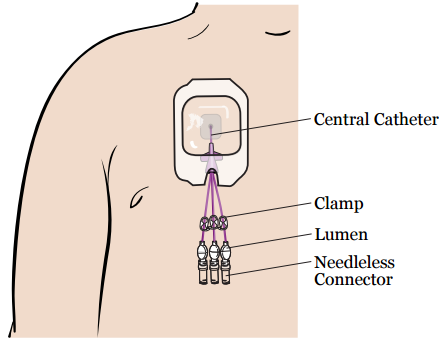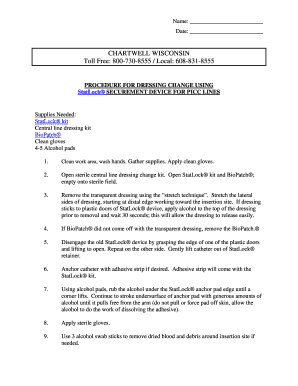central line dressing change pdf
Screw the syringe onto the clear cap and. Wash your hands thoroughly.
Sit comfortably with a good view of the site.
. With non-sterile gloves loosen and remove old dressing. Put on non-sterile gloves 5. View Central Line Dressing Changepdf from NURS FUNDAMENTA at McNeese State University.
Central line dressing kit. Central Line Dressing kit Central Line dressing PROCEDURE. Standardize tubing change 5.
May require chart review Yes No Yes No Yes No Yes No M5. Cleans site with appropriate antimicrobial solution 7. Perform hand hygiene then open dressing tray 2.
Obtain necessary supplies UIH has central line dressing change kits 2. This becomes your sterile field. Remove your clothing to expose the catheter site.
Dressing is recommend if an institution s central lineassociated bloodstream infection rate is not decreasing despite adherence to basic prevention measures including education and training appropriate use of chlorhexidine for skin antisepsis and MSB. Central Line Dressing Change Procedure Check-off 1. Take out your sterile gloves.
The catheter lays above the right atrium. The catheter stabilization device shall be changed with each dressing change. Aseptic technique for accessing and changing needleless connector 4.
Wash hands thoroughly for at least 20 seconds. Change needleless components as often as the administration set and no more often than 72 hours. Daily review of catheter necessity.
The need for the central line is assessed daily by a practitioner with prompt removal of unnecessary lines. Andor lab draws change caps every 24 hours. Clean the end of the clear cap with an alcohol wipe for 5 seconds.
If a sterile drape is provided carefully open it touching only the one inch margin and place it on the bedside table. Even in resource-poor areas of the world researchers have found that basic education and. Gauze dressing under a transparent dressing should be treated as a gauze dressing and should be changed every 2 days.
Prepare dressing tray aseptically adding supplies with transfer forceps 4. CHANGING YOUR CENTRAL LINE DRESSING SUPPLIES. Use sterile gauze or sterile transparent semipermeable dressings.
Impact of Infection CLABSIs result in increased mortality and health care costs Of all healthcare-associated infections CLABSIs cause the highest number of preventable deaths. Dressing change Complete Initials 12 Don sterile gloves. Central Line Dressing kit PROCEDURE.
Remove none adherent film and labels dressing with date of change. Apply mask to patient or if mask is not tolerated ask patient to turn head to opposite side. Carefully open 2 ChloraPreps split gauze and gauze pad.
832 Packed 50 trayscarton Central Line Dressing Change Kit with Tegaderm Dressing and Skin Protectant Swabsticks Provides the necessary components to streamline maintenance care of the central line catheter. Open dressing kit and Central line dressing package maintaining sterility. Chapter 3 focuses on evidence-based strategies and techniques for preventing central lineassociated bloodstream infections CLABSIs.
Educating healthcare personnel synergistically serves an effective measure. 45 Use with caution in patients predisposed to local skin necrosis. Staff Training and CompetencySkills Assessments Maintenance.
Carefully remove the old dressing. ASSESS Assess treat and reassess pain if present. Apply appropriate dressing to the insertion site of the central line.
Gathering old dressing in dominant hand remove clean gloves and dispose in waste receptacle. MidlineCentral Line Dressing Change Date. Proper Dressing Change 3.
Wash your hands or use hand sanitizer. If performing a dressing change a scrubbing method is used when applying CHG to the insertion site. Remove any air bubbles from the normal saline or heparin syringe by pushing on the plunger.
Approaches not recommended for CLABSI prevention are also briefly reviewed. Dressing Changes Change gauze dressing every 2 days clear dressings every 7 days unless dressing becomes damp loosened or visibly soiled then change. Inspect exit site for sign of infection.
Do not stretch gently press out towards edges to ensure adhesion 14. Put on sterile gloves. Dons clean gloves 4Rremoves old dressing correctly.
Gather your supplies on a clean surface. Apply mask pinch over nose to secure in place 4. Change intermittent infusion caps prior to all blood culture draws on central line.
Don clean gloves and mask. Central Line Maintenance Bundle 1. Open dressing kit maintaining sterility.
Skills Sheet Central Line Dressing Change 14. Remove old dressing and inspect site. Sample procedure note for documentation of central line insertion from Beth Israel Medical Center.
Explains procedure to patient. Change needleless injection caps To keep blood out of the catheter when not in use clamp the port before removing the syringe. Key points include the following.
Hands are washed before dressing change. Up to 10 cash back Appropriate dressing change is one of the basic components of the maintenance bundle described in the CDC guideline which recommends weekly dressing change or immediate replacement of wet soiled or dislodged dressing using an aseptic technique. Blood cultures from a CVC must have a physician order Blood Sampling Blood sampling using aseptic technique from central line provides easy access for blood specimens.
PROCEDURE YES NO NA 1. Components are assembled in sequence of use in a flexible package and include presaturated swab-. Don clean bouffant gown and mask with face shield then perform hand hygiene 3.
Obtain sterile Central Line and Arterial Line Dressing Tray plus dressing sterile gloves and Cavilon Dressing Change Steps. Place Medipore tape on the table. If a caregiver is changing the dressing you may lie down.
Nursing Skill Tayler Hall STUDENT NAME_____ Central Line Dressing Change SKILL NAME_____ REVIEW MODULE CHAPTER_____ Description of Skill Central lines are inserted into the large veins like the juglar vein or the vena cava. Povidone-iodine and 70 alcohol may also be used. 13 Cleanse skin with antiseptic solution using a back-and-forth motion for 30 seconds 14 Allow skin to completely air dry 15 Apply skin protectant if applicable to an area larger than the securement device anchor pad allowing it to dry to the touch 16 Apply securement device if applicable to.
Chlorhexidine solution is preferred for skin antisepsis. If using betadine swab sticks open packages and have a patient hold. Central Line Dressing Change external icon Video for staff education on central line dressing changes from the Armstrong Institute for Patient Safety and Quality at Johns Hopkins.
Assesses site for signs of complications. One dressing change label CATALOG NO.

Picc Cfch Centre For Clinical Haematology

Statlock Picc Neonate Stabilization Device Bard Access Systems Pdf Catalogs Technical Documentation

How Do I Change A Picc Dressing Peripherally Inserted Central Catheter Youtube Catheter Usb Microphone Dressing

Iv Tunneled Central Venous Catheter Care At Home

Cvl Picc Dressing Change Procedure

Central Line Dressing Change Nursing Skills Youtube

About Your Central Venous Catheter Cvc For Pediatric Patients Memorial Sloan Kettering Cancer Center

3m Picc Cvc Securement Device 3m Tegaderm Chg Chlorhexidine Gluconate I V Securement Dressing 3m United States

Picc Line Dressing Change Documentation Sample Fill Online Printable Fillable Blank Pdffiller